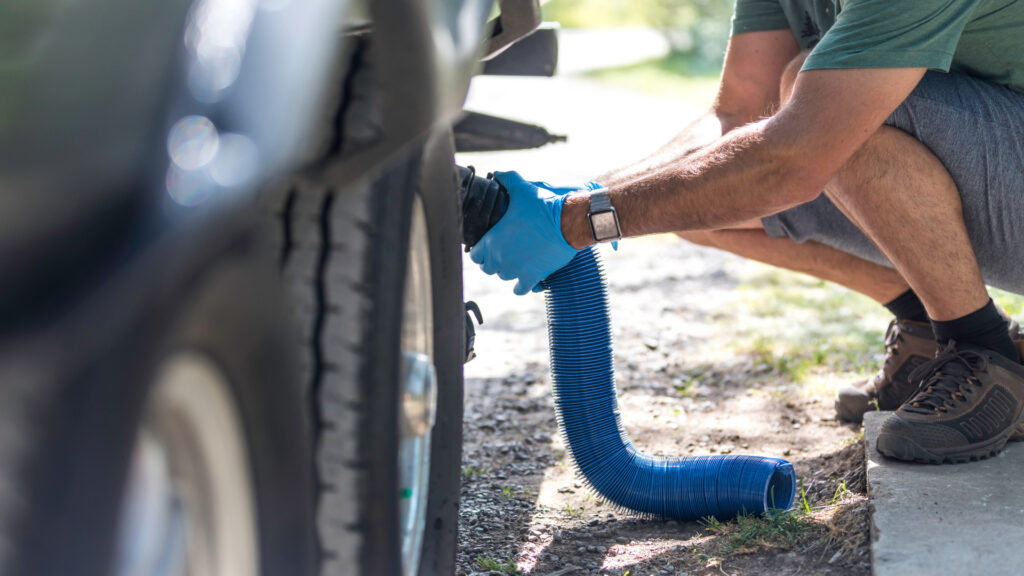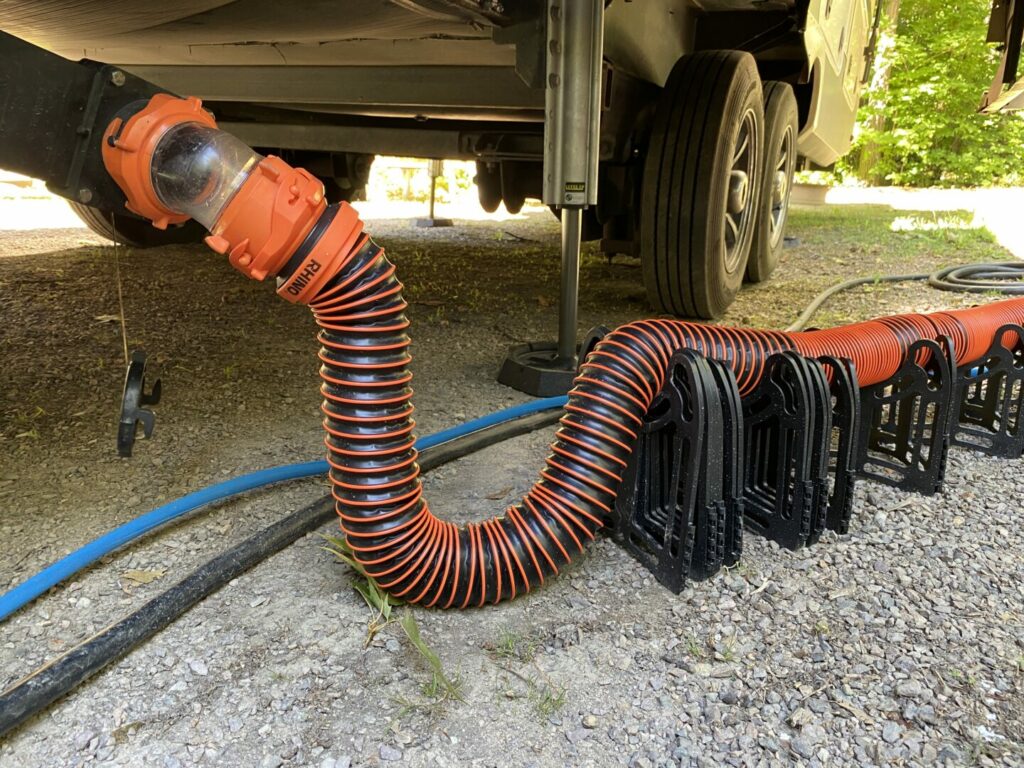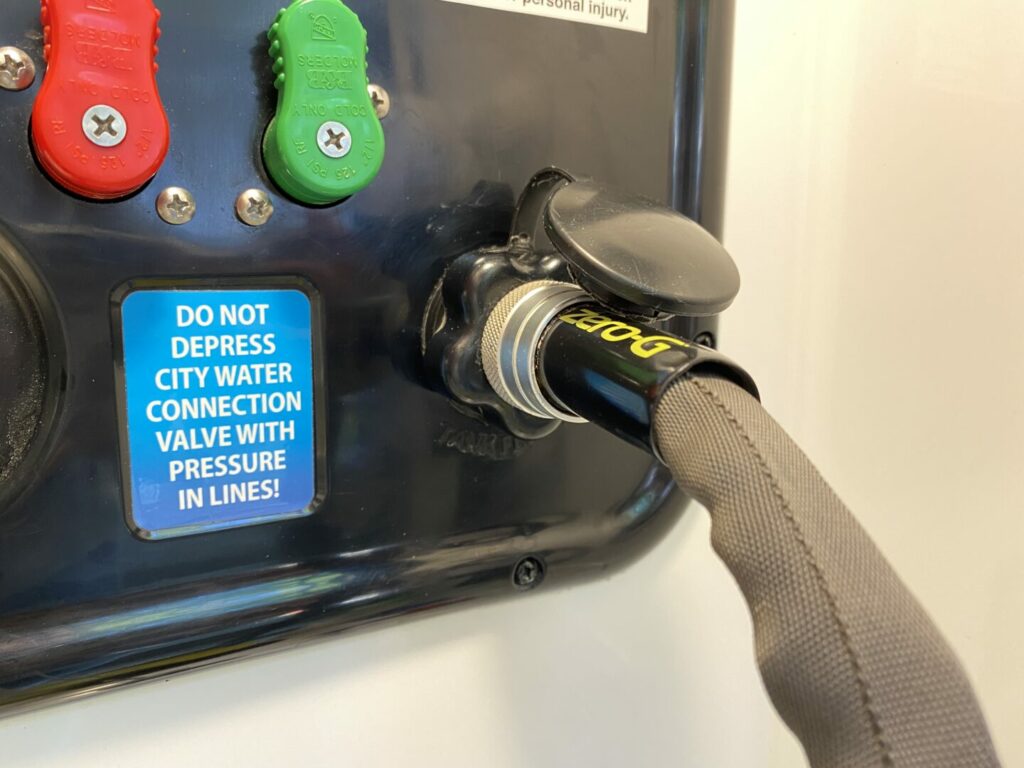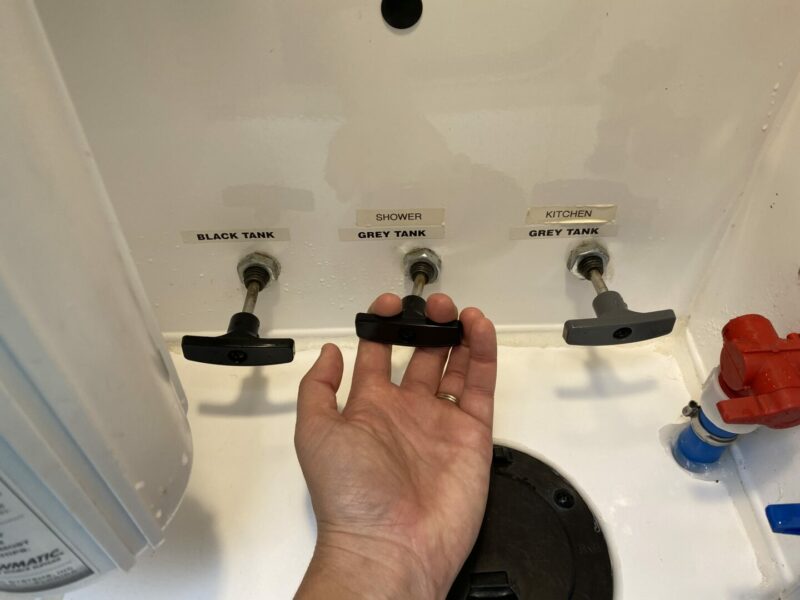Table of Contents Show
There’s so much to learn when it comes to RVing, especially when you’re new. One thing people constantly wonder about is whether they can leave their black and gray tanks open. Today we’ll take a look at how you should handle your tanks. Let’s get started.
What’s the Deal with RV Holding Tanks?
There’s a significant difference between your black and gray tanks. A black tank holds any water that has passed through a toilet. This includes human waste that you need to dispose of in a sanitary manner.
Your RV will also likely have a gray tank, which holds water from showers and faucets. Gray water also includes water from your kitchen sink, which may contain food particles. Despite gray water not containing raw human sewage, it can still smell terrible.
Full Hook-Ups Are Luxurious
Many RV parks have full hook-up sites. Keeping your RV connected to the sewer drain and being able to empty your tanks quickly is a luxury. It can save you a lot of time and hassle.
RVers love full hook-ups because of the convenience. You won’t have to worry about dumping your tanks into a portable tote or finding a dump station. You can quickly and easily empty your tanks without having to pack up your entire site each time.
However luxurious full hook-ups may be, this is also where people wonder about leaving their tanks open. Let’s see why you should keep them closed even here.

Black Tanks on Full Hook-Ups: Leave Closed
It’s a common mistake many RVers make to leave their black tanks open when using full hook-ups. Leaving your black tanks open allows any liquids that enter your tank to drain out immediately. This becomes a problem as any solids in the tank get left behind.
A “poo pyramid” can form in a tank as the solids gather over time. It doesn’t take long for these solids to fuse. They can create a mass that’s too large to pass through the valve for dumping. This will clog your tanks and cause a frustrating and disgusting situation.
You can reduce your chances of a “poo pyramid” by keeping your black tank closed and using a lot of water with each flush. This will help solids break down while they’re in the tank. When you empty the tank later, the force from the water rushing out will wash out the solids as well.
Pro Tip: Add a scoop of Happy Camper to each gray and black tank to help break down any solids, and keep any smells at bay.
How Long Does it Take a Black Tank to Fill Up?
The amount of time it takes for you to fill up your black tank varies from one RV to the next and one camping style to the next. Black tanks come in a range of sizes, typically from 20 to 60 gallons. You can find some 100-gallon tanks out there. Check the owner’s manual for your RV if you aren’t sure what size tanks you have.
Another factor to consider is how many people will be using the restroom in your RV. A large family will fill the tank faster than a solo traveler or a couple. Just for references, it takes two of us almost two full weeks to fill our 50-gallon black tank.
If you’re camping in a campground, you can keep your black tanks clear by using the campground’s facilities. There are even some RVers who strictly camp in established campgrounds and use the campground bathrooms. Meaning, they don’t use the restroom in their RVs.
Gray Tanks on Full Hook-Ups: Leave Open
Many RVers leave their gray tanks open until a day or two before they plan to dump their black tanks. This allows them to dump their black tank and then use the soapy gray water to rinse the sewer hose. This helps avoid smells or gross sewage.
Your kitchen gray tank needs a good flush now and then too. Food particles from washing dishes can collect in the bottom of your gray tank. It’s essential to fill up your gray tank regularly to flush it out. You don’t want rotting food particles sitting in your gray tank. That can lead to smells that could even compete with black tank odors.
Pro tip: If you’re going to leave your gray tanks open, create a “U” shape with your sewer hose and ensure some water gets in there. This prevents any smell or sewer flies from being able to enter your system.

Will Odors from RV Sewers Get in My RV?
RV plumbing systems use a mechanism known as P-Trap to keep odors out of the living space. A P-Trap uses two 90-degree joints and an overflow pipe to hold water to block odors from passing through.
Alternatively, if your RV doesn’t appear to have a P-Trap, you might have an air admittance valve. This valve has the same function as a P-Trap and keeps the sewer smell from entering your RV.
From time to time, you may catch a whiff of something from your system. Typically you’ll only smell it while dumping your tanks. If the smell lingers, you may need to check that your P-Trap is working correctly.
- ABS construction
- Helps prevent sewer gas from entering your home
How Often Should You Rinse and Clean Your Holding Tanks?
The more you use your RV, the more often you need to rinse and clean your holding tanks. If you use your RV for weekend trips, you should rinse and clean your holding tanks after every trip. You don’t want raw sewage or food particles to sit in your tanks, especially if it will be weeks or months between usages.
Many full-time RVers will rinse and clean their tanks whenever it’s convenient. This means when they are at full hookup sites or at a dump station. We typically clean our tanks the day before or the day of leaving a full hookup site.
We try to clean our tanks every time we dump, but that’s not always possible. When that happens, we just note that we might need a few extra rinses the next time we have full hookups.

Are Holding Tank Sensors Accurate?
It’s a common joke in the RVing community that the holding tank sensors are only accurate until you use the restroom for the first time. If anything sticks to the sensor, it will give a false reading of being more full than it actually is. Sensors may indicate a nearly full tank even right after you’ve emptied it.
Many RVers use tricks like putting dish soap in their tank, using large amounts of water, or even dumping a bag of ice into the tank. These methods aren’t guaranteed. The more you use your RV, the more you’ll learn the tricks and intuit the status of your tanks.
One trick many RVers use for knowing when to empty their black tanks is to listen for the “burp.” As liquids and solids take the place of air in your tanks, you may hear a burp. That’s when you’ll know it’s time to empty your black tank.
Pro Tip: If you really want to be able to rely on your tank sensors though, you can always upgrade to the SeeLevel Tank Monitoring System.
In Conclusion: Gray Tank Open, Black Tank Closed
While dumping your tanks is never a glorious job, connecting to a full hook-up site allows you to worry about it less. Remember that while you can leave your gray tank open, you should only open your black tank after it has filled and you’re ready to dump. Doing so can help save you from the dreaded “poo pyramid” and get you back to RVing. How often do you clean your tanks?
Last update on 2024-12-25 / Affiliate links / Images from Amazon Product Advertising API







